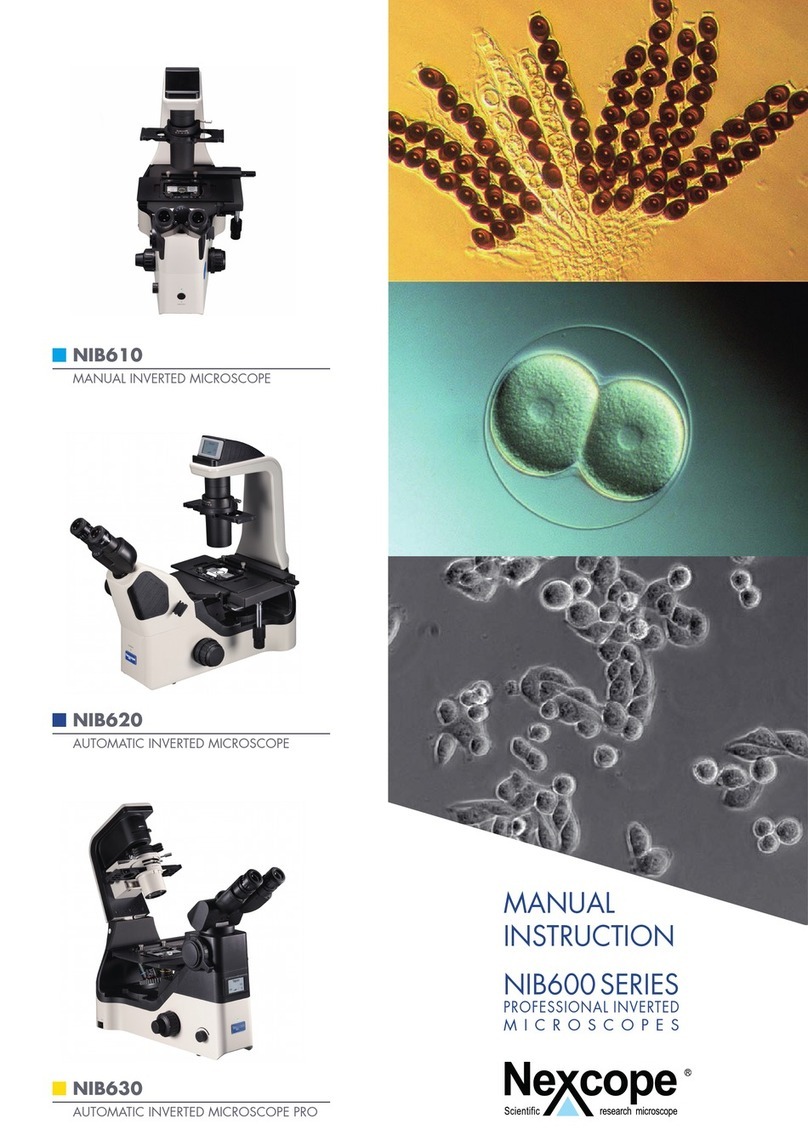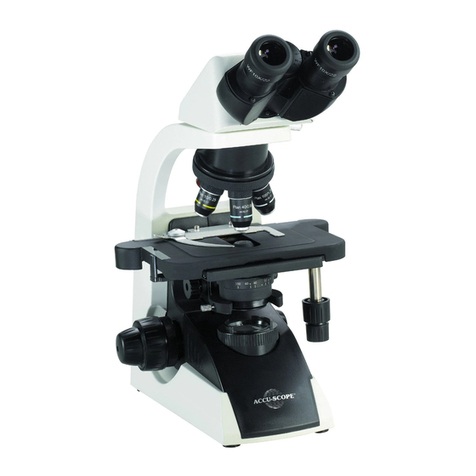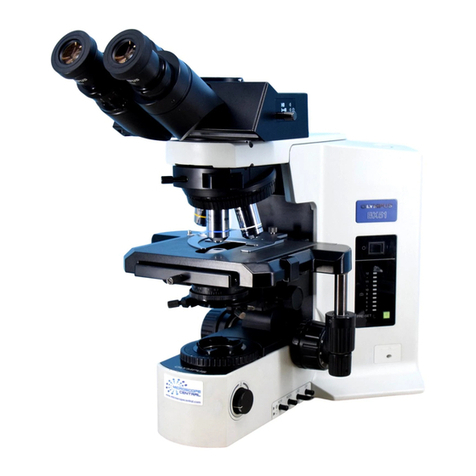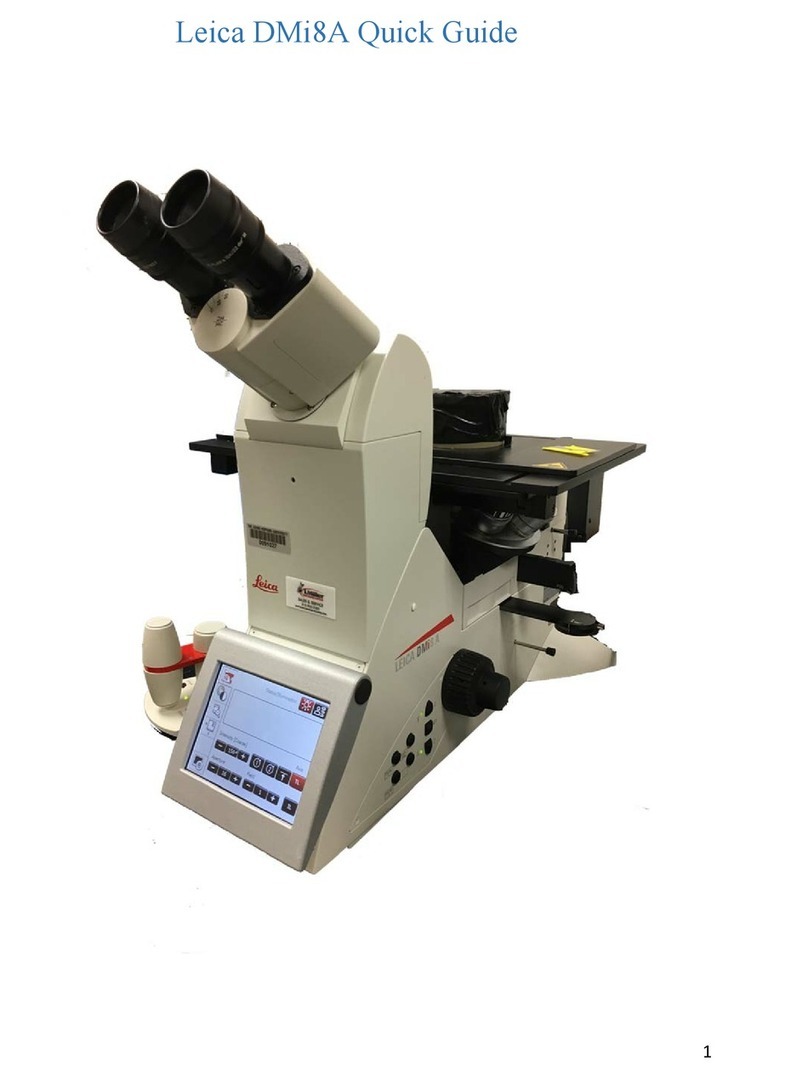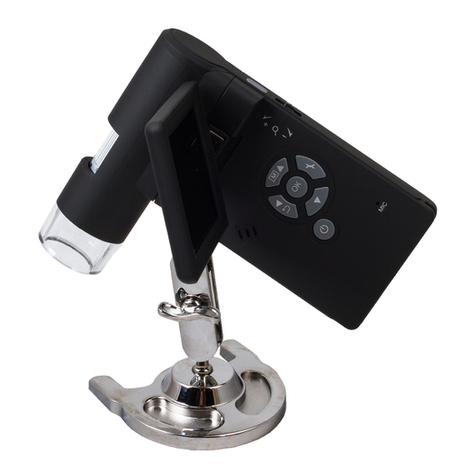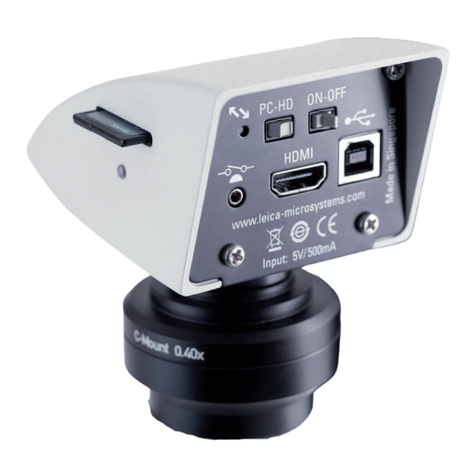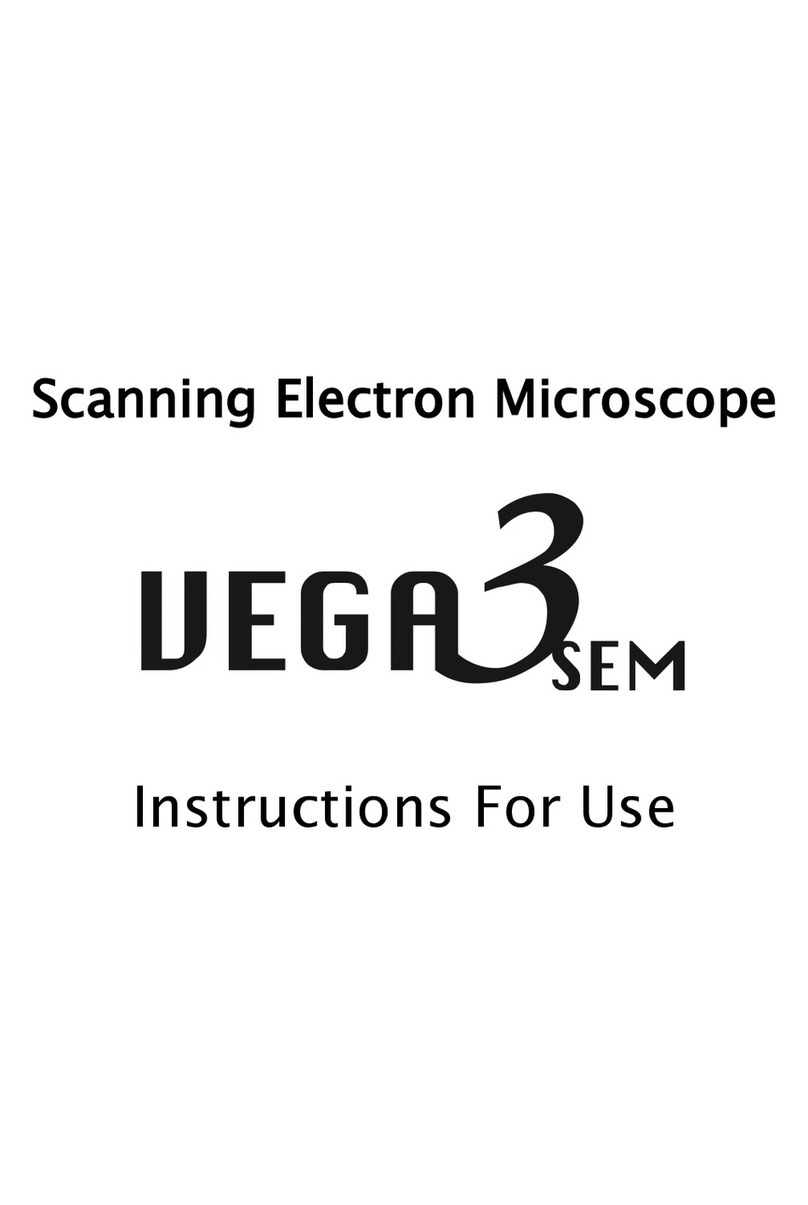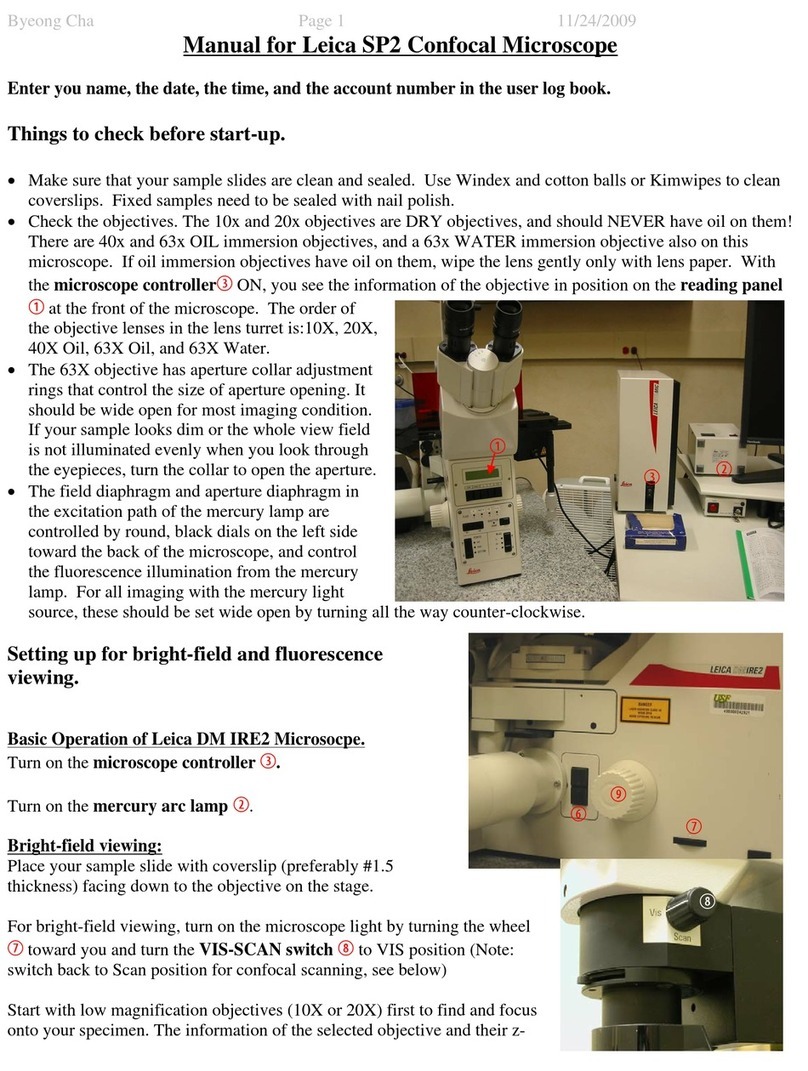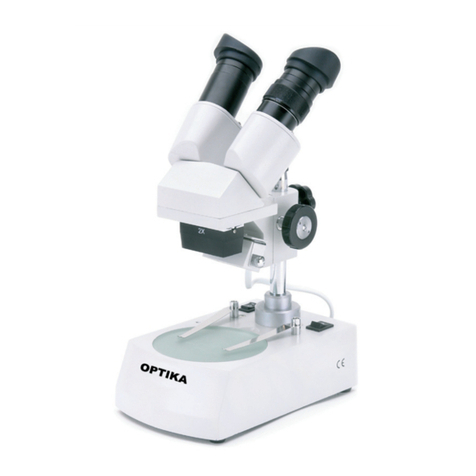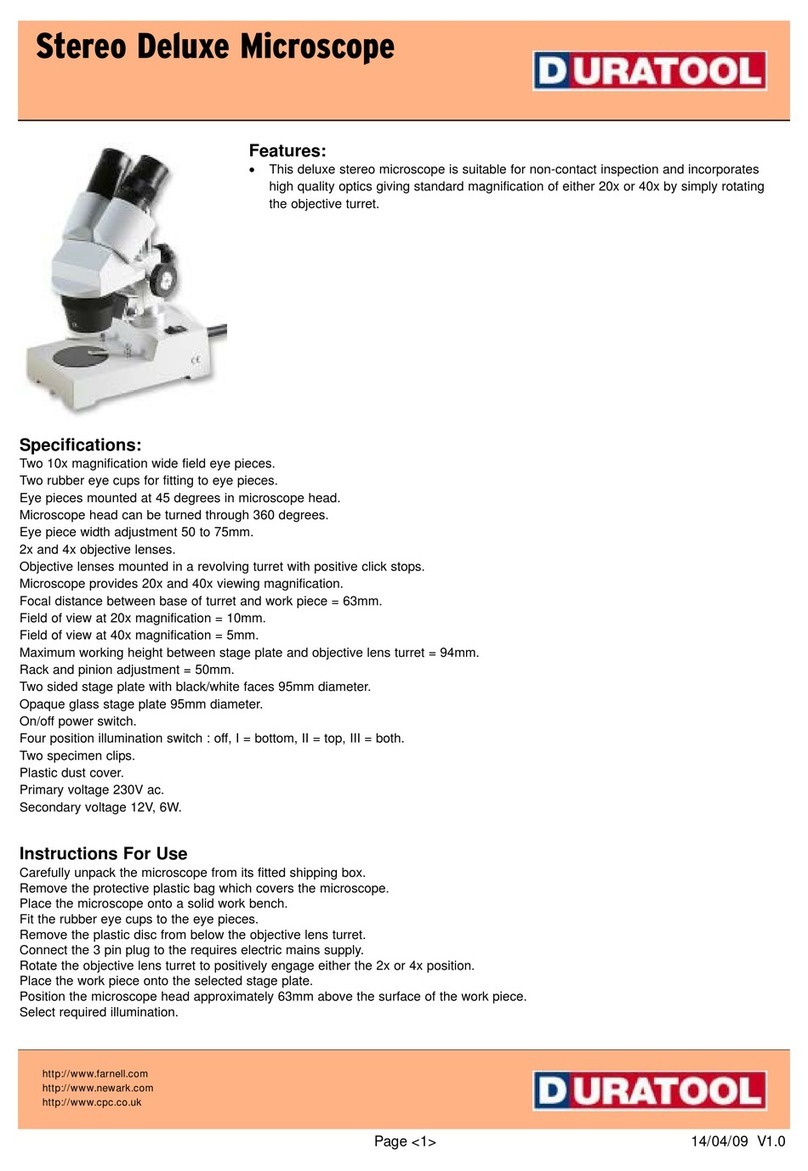Nexcope NE620T User manual

NE620T
UPRIGHT RESEARCH
MICROSCOPE
NE620T
UPRIGHT BIOLOGICAL MICROSCOPE
FOR PROFESSIONAL APPLICATIONS
INSTRUCTION MANUAL

2
INTRODUCTION
WE CONGRATULATE YOU
on your purchase of the professional research microscope NEXCOPE
NE620T. It has been carefully manufactured with materials of lasting
value, and careful attention has been paid to function and reliability.
This microscope is designed for a wide range of applications. It fea-
tures a very high contrast, which ensures an outstanding image quality
and resolution. This makes it ideal for demanding and professional ap-
plications. The eyepieces have a 22 mm field of view. This produces a
wide-angle image for a more comprehensive observation content and
faster sample observation. The intelligent automatic brightness control
and the ergonomic design ensure the user can perform microscope
operation in the most comfortable situation. The Nexcope microscopes
are very robust, but need a certain amount of attention and care to
guarantee their longevity. We therefore recommend that you read this
user manual carefully and keep it within reach for your reference while
working with the microscope. It contains all relevant information on op-
eration, user safety and care. If you follow the guidelines, your micro-
scope will function reliably and smoothly even after years of intensive
use.
We wish you much success in your work with your new microscope!
The operating instructions can be downloaded
from the following web address:
https://www.bresser.de/Mikroskopie/Mikroskope
i
INTRODUCTION

3
i
GARANTIE · WARRANTY · GARANTÍA · GARANZIA
Besuchen Sie unsere Website über den folgenden QR Code oder Weblink um weitere Informationen zu die-
sem Produkt oder die verfügbaren Übersetzungen dieser Anleitung zu finden.
Visit our website via the following QR Code or web link to find further information on this product or the avai-
lable translations of these instructions.
Si vous souhaitez obtenir plus d’informations concernant ce produit ou rechercher ce mode d’emploi en d’au-
tres langues, rendez-vous sur notre site Internet en utilisant le code QR ou le lien correspondant.
Bezoek onze internetpagina via de volgende QR-code of weblink, voor meer informatie over dit product of de
beschikbare vertalingen van deze gebruiksaanwijzing.
Desearía recibir unas instrucciones de uso completas sobre este producto en un idioma determinado? Enton-
ces visite nuestra página web utilizando el siguiente enlace (código QR) para ver las versiones disponibles.
Desidera ricevere informazioni esaustive su questo prodotto in una lingua specifica? Venga a visitare il nostro
sito Web al seguente link (codice QR Code) per conoscere le versioni disponibili.
DE
EN
FR
NL
ES
IT
www.bresser.de/warranty_terms
www.bresser.de/download/nexcope
We recommend that you study this manual thoroughly before operating the microscope for the first
time. It will help you become fully familiar with the equipment and achieve optimum performance.
Keep this manual in an easily accessible place near the work area for future reference.
Changes in the interest of the technical development are reserved. These instruction manual is not
subject to the revision service. The reproduction of this document as well as the use and communi-
cation of its contents are not permitted unless expressly permitted. Contraventions obligate to com-
pensation for damages. All rights in the event of a patent being granted or utility model registration
reserved.
WARRANTY TERMS

4
i
DE
AT
CH
BE
Bei Fragen zum Produkt und eventuellen Reklamationen
nehmen Sie bitte zunächst mit dem Service-Center Kontakt
auf, vorzugsweise per E-Mail.
E-Mail: service@bresser.de
Telefon*: +4928728074210
BRESSER GmbH
Kundenservice
Gutenbergstr. 2
46414 Rhede
Deutschland
*Lokale Rufnummer in Deutschland (Die Höhe der Gebühren je Telefonat
ist abhängig vom Tarif Ihres Telefonanbieters); Anrufe aus dem Ausland
sind mit höheren Kosten verbunden.
GB
IE
Please contact the service centre first for any
questions regarding the product or claims,
preferably by e-mail.
Telephone*: +441342837098
BRESSER UK Ltd.
Customer Support
Suite 3G, Eden House
Enterprise Way
Edenbridge, Kent TN8 6HF
United Kingdom
*Number charged at local rates in the UK (the amount you will be
charged per phone call will depend on the tariff of your phone provider);
calls from abroad will involve higher costs.
FR
BE
Si vous avez des questions concernant ce produit
ou en cas de réclamations, veuillez prendre contact
avec notre centre de services (de préférence via
e-mail).
E-Mail: sav@bresser.fr
Téléphone*: 00 800 6343 7000
BRESSER France SARL
Service après-vente
Pôle d’Activités de Nicopolis
314 Avenue des Chênes Verts
83170 Brignoles
France
*Prix d'un appel local depuis la France ou Belgique
NL
BE
Als u met betrekking tot het product vragen of
eventuele klachten heeft kunt u contact opnemen
met het service centrum (bij voorkeur per e-mail).
Telefoon*: +31528232476
BRESSER Benelux
Klantenservice
Smirnoffstraat 8
7903 AX Hoogeveen
The Netherlands
*Het telefoonnummer wordt in het Nederland tegen lokaal tarief in
rekening gebracht. Het bedrag dat u per gesprek in rekening gebracht
zal worden, is afhankelijk van het tarief van uw telefoon provider;
gesprekken vanuit het buitenland zullen hogere kosten met zich
meebrengen.
ES
IT
PT
Si desea formular alguna pregunta sobre el
producto o alguna eventual reclamación, le
rogamos que se ponga en contacto con el centro
de servicio técnico (de preferencia por e-mail).
Teléfono*: +34 91 67972 69
BRESSER Iberia SLU
Servicio al Cliente
c/Valdemorillo,1 Nave B
P.I. Ventorro del Cano
28925 Alcorcón Madrid
España
*Número local de España (el importe de cada llamada telefónica
dependen de las tarifas de los distribuidores); Las llamadas des del
extranjero están ligadas a costes suplementarios..
You can obtain additional information from your customer service:
SERVICE

5
i
1. Important notes ......................................................................................................6
1.1. Imprint/validity information........................................................................................6
1.2. About this instruction manual/intended use.............................................................6
1.3. General safety instructions..........................................................................................7
1.4. Safety symbols used in the manual ........................................................................ 10
1.5. Safety symbols on the microscope.......................................................................... 10
1.6. Check scope of delivery and handling ................................................................. 11
1.7. Site location .............................................................................................................. 11
1.8. Cleaning/maintenance/transport ......................................................................... 12
1.9. Protection and storage ............................................................................................ 13
1.10. Disposal ..................................................................................................................... 14
2. Introduction............................................................................................................15
2.1. What you can expect… .......................................................................................... 15
3. Design of NE620T ...............................................................................................16
3.1. Product image NE620T - biological microscope ................................................. 16
NE620T front/side view.......................................................................................... 16
NE620T back/side view ......................................................................................... 17
3.2. Assembly of the NE620T microscope.................................................................... 18
4. Start-up and Operation ...................................................................................23
4.1. Setting up power supply .......................................................................................... 23
4.2. Placing the specimen................................................................................................ 24
4.3. Observationtubus...................................................................................................... 25
4.4. Focusing the specimen ............................................................................................. 26
5. Various Observation methods......................................................................36
5.1. Dark field observation.............................................................................................. 36
5.2. Phase contrast observation...................................................................................... 39
5.3. Polarization observation .......................................................................................... 44
5.4. Fluorescent observation............................................................................................ 49
6. Equipment overview .........................................................................................54
6.1. Main specifications................................................................................................... 54
6.2. Objective parameters............................................................................................... 55
7. Trouble shooting guide.....................................................................................56
7.1. Optical system ........................................................................................................... 56
7.2. Mechanical system.................................................................................................... 57
7.3. Electrical system......................................................................................................... 58
8. Warranty.................................................................................................................59
TABLE OF CONTENTS

6
1
1. IMPORTANT NOTES
This chapter informs the user about the general instructions for the microscope and the im-
portant safety symbols.
1.1. Imprint/validity information
Imprint
Bresser GmbH
Gutenbergstraße 2
46414 Rhede Deutschland
http://www.bresser.de
For information regarding liability claims or service requests, please refer
to chapters "Warranty" and "Service" in this documentation. Errors re-
served - technical specifications subject to change.
Copyright: 2022 Bresser GmbH
All rights reserved.
It is not allowed to reproduce this documentation or parts of it in any kind (e.g. photocopy-
ing, printing, etc.) without written a permission of the manufacturer or the distributor, Bresser
GmbH. It is also prohibited to use or transmit this documentation with electronic systems
(e.g. image file, website, etc.). The descriptions and brand names of the corresponding
firms used in this documentation are generally protected under trademark, brand and/or
patent law for Germany, for the European Union and/or other countries.
Validity information
This documentation is valid for the products with the article numbers listed below:
NX20620
Manual version: v122021a
Manual description: Manual_NE-620T_en_NEXCOPE_v122021a
inquiries, please state these information.
1.2. About this instruction manual/intended use
About this instruction manual
These operating instructions are to be considered a component of the device.
PLEASE READ THE SAFETY INSTRUCTIONS AND THE OPERATING
INSTRUCTIONS CAREFULLY BEFORE USE. Keep these instructions available
for further reference when using the microscope. When the device is sold or giv-
en to someone else, the instruction manual must be provided to the new owner/
user of the product.
Intended use
• This product is intended for private and corporate use.
• It was developed for the magnified display of things in nature.
• The device is intended only for indoor use.
This device is not intended for use by individuals (including children) with limit-
ed physical, sensory or mental capabilities or those lacking in experience and/or
knowledge, unless they are supervised by an individual responsible for their safety or
have received instructions from them regarding the use of the device.
IMPORTANT NOTES

7
1
1.3. General safety instructions
Danger of an electric shock!
This device contains electronic components that operate via a power source (power supply
and/or batteries). In case of any improper use of this device, there is a risk of an electric
shock. An electric shock can cause severe injury or even death. Therefore please read the
safety instructions below to avoid an explosion.
• Disconnect the device from the power supply by pulling the power plug when it is not
used or in case of longer interruption of operation and before starting any work on
maintenance and cleaning.
• Position your device so that it can be disconnected from the power supply at any time.
The wall socket you use should be located near the device and easily accessible, since
the plug on the power cable serves as a disconnecting device for the power supply.
• Always pull on the plug to seperate the device from the power supply. Never pull on
the cable.
• Before operating, check the device, cables and connections for dammage.
• Never use a damaged unit or a unit with damaged power cables. Damaged parts must
be exchanged immediately by an authorised service centre.
• Only use the device in complete dry environment and do not touch it with wet or moist
parts of your body.
• The microscope is equipped with a plug-in power supply unit which allows the use of
mains voltage values in the range of 100 to 240 V, 50 / 60 Hz, without additional
voltage adjustment on the device.
• To avoid electric shock, connect the supplied power cord to a properly grounded power
outlet on. These power cords have three-pin plugs to ensure proper grounding.
Danger of choking!
In case of any improper use of this device, there is a risk of choking, especially for children.
Therefore please read the safety instructions below.
• Keep packaging material, like plastic bags and rubber bans, out of the reach for chil-
dren, as these materials pose a choking hazard!
Danger of explosion!
In case of any improper use of this device, there is a risk of an explosion. Therefore please
read the safety instructions below to avoid and explosion.
• Do not expose the device to high temperatures. Use only the supplied power adapter.
Do not short-circuit the device or throw them into a fire. Excessive heat or improper
handling could trigger a short-circuit, a fire or an explosion.
• Do not use the microscopes and the accessories supplied with them in potentially ex-
plosive atmospheres, in the presence of flammable solvents such as alcohol, petrol or
volatile anaesthetics, etc..
IMPORTANT NOTES

8
CAUTION: Danger of injury!
This device contains components and/or accessories that can cause minor to severe injuries
in case of any improper use. Therefore please read the safety instructions below to avoid
any bodily injury.
• Tools with sharp edges and points are often used when working with this device. Be-
cause there is a risk of injury from such tools, store this device and all the tools and
accessories in a location that is out of the reach of children.
• Children must not have access to the included chemicals and liquids. Do not drink the
chemicals. Wash hands thoroughly with running water after using the chemicals. In the
event that the chemicals come into contact with your eyes or mouth, rinse thoroughly
with water. If you are in pain after exposure, contact a doctor immediately and take the
substances with which you came into contact with you.
CAUTION: Fire hazard!
In case of any improper use of this device, there is a risk of fire. Therefore please read the
safety instructions below to avoid the initiation of burning.
• Never cover the ventilation slots or cooling fins of the device while using it or as long as
it has not sufficiently cooled down!
NOTICE: Risk of property damage!
In case of any improper use of this device and/or its accessories, there is a risk of property
damage. Therefore only use the device according to the safety instructions below.
• Do not disassemble the device. In the event of a defect, please contact your dealer.
The dealer will contact the Service Centre and can send the device in to be repaired,
if necessary.
• Do not expose this device to higher temperatures and protect it from water and high
humidity.
• Protect the device from severe shocks!
• For this device only use accessories and spare parts that comply with the technical
information.
• Always use the power cord supplied by Nexcope. If an unsuitable power cord is used,
Nexcope can no longer guarantee the electrical functionality and safety of the micro-
scope.
• Avoid inserting metal objects into the ventilation slots on the underside and the back of
the microscope. Otherwise, there is a risk of damage to the instrument, electric shock
or injury.
• Use these microscopes and their original accessories only for the applications described
in this manual.
• The manufacturer does not accept any liability for any other application, possibly also
for individual assemblies or individual parts. This also applies to all repair and service
work that is not carried out by authorised service personnel. Therefore all guarantee /
warranty claims expire.
• NEXCOPE NE620T is not equipped with any special device to protect against cor-
rosive, toxic, potentially infectious or radioactive samples or other samples that are
harmful to health. All legal requirements, in particular national regulations for accident
prevention, must be observed when handling such samples.
• This microscope will not cause radiation and the electromagnetic interference to the
surrounding environment, totally accordance with the EMC certification standards.
ATTENTION!
1
IMPORTANT NOTES

9
The microscope is equipped with a green and blue LED illumination. Neve look direct-
ly into the illumination or directly at the illuminated specimen. Only look through the
eyepieces if the correct filter is set, or through the radiation shield.
Note!
If you have any complaints or queries please contact your national service centre by
telephone. The address is included in these instructions.
LED fluorescent attachment - CAUTION: LED radiation
LED class 3B, 3W LED, FL-B (blue excitation: 460-495 nm), FL-G (green excitation: 510-550 nm)
• Do not expose to the beam. Avoid irradiation of the skin!
IMPORTANT NOTES
1

10
1.4. Safety symbols used in the manual
Danger symbols
Warning of a danger point
This symbol indicates information that must be read and observed.
Non-observance can lead to:
o Risk of injury
o Malfunctions or equipment damage
Warning of dangerous electrical voltage
This symbol precedes information that must be read and observed.
Non-observance can lead to:
o Risk of injury
o Malfunctions or equipment damage
Warning symbol
Warning symbol indicates a possible source of danger
Failure to follow the warnings may result in injury to the user and/or
damage to the microscope (including nearby objects).
Note symbol
Important additional hint
Accompanying instructions serve to simplify operation and maintenan-
ce.
1.5. Safety symbols on the microscope
The following symbols are located on the microscope/accessories and
should always be observed:
The device manufacturer is legally obliged to take back
defective devices for recycling.
EC Declaration of Confirmity
Bresser GmbH has issued a “Declaration of Conformity” in accordance
with applicable guidelines and corresponding standards.
Caution LED Radiation
The LED module of the incident light fluorescence lighting system emits
class 3B LED light. Direct exposure to the light and direct incidence of
light on the skin must therefore be avoided at all costs. When micro-
scopes are used, the protective devices provided with the microscope
must always be used. Never - neither with nor without optical instru-
ments - look into the light beam, not even to simply look at the sample.
Failure to observe this warning may result in eye damage!
1
IMPORTANT NOTES

11
1.6. Check scope of delivery
• Open the packaging with care. Avoid fingerprints and sweat on the camera lens. Pre-
vent the camera and some accessories from falling and being damaged.
• Remove all components from the packaging and check for completeness according to
the delivery note. The microscope could be packaged in more than one carton depend-
ing on the model or accessories.
• Handle the microscope with care and always protect it against violent impact and
vibrations.
• Keep the original packaging for possible longer storage or return of the device to the
supplier in case a repair or revision is needed.
Never lift the microscope by the cross stage, trinocular viewing head or coarse/
fine focusing knobs. This can damage the microscope!
• Always carry the microscope with both hands.
• On the upper part of the microscope body there is a carrying handle.
• The microscope back plate is designed with a holing device to effec-
tively store the long power cord, improve the cleanliness of the labo-
ratory, and reduce the tripping accident caused by the long power
cord during the carrying process.
1.7. Site location
• Select a suitable location before setting up the microscope.
• Place the microscope on a resistant surface away from strong sunlight, heat sources,
high humidity, high dust exposure as well as strong vibration.
Do not expose the device to temperatures below 5°C or higher than +30°C! If
the device is exposed to temperatures outside this range, this will cause irreparable
damage to optical and/or mechanical parts which are not covered by warranty.
›Working temperature: 0°C℃~40°C℃;
›Maximum relative humidity: it is 80% for temperature of 31°C℃, the following is the
linear decrease, 70% for 34°C℃, 60% for 37°C℃, 50% for 40°C℃;
›The highest elevation is 2000m
›Storage and transport environment:
›Range of working temperature: -25°C℃~+65°C℃
›Range of relative humidity: 0%~90%
• Place the microscope on a surface that meets the following criteria:
›Flat / Level
›Vibration-free
›Hard surface and non-flammable
›Chemical and mechanical resistant
• Place the microscope so that:
›The ventilation slits on the underside are not blocked
›There is at least 10 cm clearance around the device or to other devices or the wall.
›You can disconnect it from the mains at any time
• The mains cable must be freely accessible at all times, as the mains cable is intended
as a disconnecting device from the mains.
• Make sure the residual moisture is fully eliminated before use.
• For use in warm and humid climates, all optical components of the microscope are
already equipped with protection against fungus infestation.
IMPORTANT NOTES
1

12
1
1.8. Cleaning/maintenance/transport
Disconnect the device from the power supply by pulling the power plug when it is
not used or in case of longer interruption of operation and before starting any work
on maintenance and cleaning.
Disassemble optical elements (e.g.objective, eyepiece, etc.) before cleaning.
Be sure that the instrument is dry before using.
Do not use organic solvents (e.g. alcohol, ether, acetone, xylol or other dilutions)
to clean lacquered parts or plastic parts!
Alcohol is highly flammable.
To avoid damaging the electronics, do not use any cleaning fluid.
When using objects that present a potential risk of infection, all parts that have
come into contact with the object must be thoroughly cleaned.
The nosepiece, the coarse/fine focusing mechanism and the condenser are pre-
cisely designed and aligned. Please avoid dismantling the components. This affects
the performance of the microscope.
Transport: Please remove all loose parts and the object to be observed from the
stage. Only use the original packaging for transport.
Cleaning microscope body / optical elements
• Only use a dry cloth to clean the exterior of the device.
• Disassemble optical elements (e.g. objective, eyepiece, etc.) before cleaning.
• Blow away loose dust from the lens surfaces first.
• Use high quality lens cleaning towels or soft cloth and moisten it with a little bit of pure
alcohol (available in a drug store). Wipe the lens surface with it.
Cleaning the 100x immersion oil objective
• The immersion oil/ cedar oil should be removed from the lens at the end of each work-
day.
• Clean the 100x objective by dabbing off the oil with a soft baby paper tissue. When
the immersion lens is used regularly, wet clean the lens only once a week, Use a solu-
tion of 70% ethanol or isopropanol (use p.a. or pharmacy grade alcohol and double
distilled water to make such a solution).
IMPORTANT NOTES

13
1
Immersion oil
• When using immersion oil, it is essential to read the relevant safety data sheet.
Immersion oil irritates the skin. Therefore avoid contact with skin, eyes and clothing.
• In case of skin contact: wash off with plenty of water and soap.
• In case of eye contact: rinse immediately with plenty of water for at least
5 minutes.
• In case of prolonged irritation: consult a specialist.
Depending on the type of oil used, it might be harmful to the environment, espe-
cially aquatic organisms.
1.9. Protection and storage
• Protect the device against dust and moisture.
• Avoid putting fingerprints and equal contaminations on any optical surfaces.
• Pull a dust protection cover over the microscope. Before covering the microscope, al-
ways check that the microscope is also switched off.
• Store it in a closed container at a dry and mould-free place.
• Store the microscope and the accessories in the relevant containers when they are not
used for a longer time.
• It is recommended to store also objectives and eyepieces in closed containers with
desiccant.
A dust protection cover is included in delivery.
Remember:
A well maintained microscope will keep its optical quality for years and thus main-
tain its value.
IMPORTANT NOTES

14
1
1.10. Disposal
Dispose of the packaging materials properly, according to their type, such as paper or card-
board. Contact your local waste-disposal service or environmental authority for information
on the proper disposal.
Do not dispose of electronic devices in the household garbage!
As per Directive 2002/96/EC of the European Parliament on waste electrical and
electronic equipment and its adaptation into German law, used electronic devices
must be collected separately and recycled in an environmentally friendly manner.
The device manufacturer is legally obliged to take back defective devices.
IMPORTANT NOTES

15
EXCELLENT OPTICAL DESIGN
NIS INFINITY PLAN OBJECTIVES can provide high con-
trast and very flat image with sharp, excellent resolution
and high signal-to-noise ratio imaging. NE620T achieves
the wide field of 22 mm view with 10x eyepieces for a
more comprehensive observation content and faster sam-
ple observation.
INTELLIGENT OPERATING SYSTEM
CODED NOSEPIECE
NE620T can memorize the illumination brightness for
each objective and automatically adjust the light intensity.
This improves work efficiency and reduces visual fatigue.
The Liquid Crystal Display (LCD)
The LCD shows the usage status of the microscope, includ-
ing magnification, light intensity, sleep mode and more.
MULTIFUNCTIONAL UNIVERSAL
CONDENSER
Universal condenser for bright field, dark field and phase
contrast: The observation methods could be quickly
switched by switching the slider. There are two phase
contrast sliders universal for 10/20/40/100 objectives
also, simple and fast to use.
ERGONOMIC DESIGN /
WIDE APPLICATION
NE620T uses an ergonomic design, high eye-point,
low-hand focus mechanism, low-hand stage and other
ergonomic designs to ensure the user can perform mi-
croscope operation in the most comfortable situation.
As a continuously upgradeable microscope, the
NE620T can be extended by a variety of observation
possibilities.
2
2. INTRODUCTION
2.1. What you can expect…
Ø 18 mmØ 18 mm
Ø 22 mmØ 22 mm
INTRODUCTION

16
3. DESIGN OF NE620T
3.1. Product image NE620T – biological microscope
3
DESIGN OF NE620T
Illustration 001: Product image of NE620T front/side view.
A NE620T front/side view
BASIC DESIGN
1. Main body
2. Condenser up-down knob
3. Left fine focusing knob
4. Coarse focusing knob
5. Tension adjustment ring
6. On/Off switch
7. Brightness control knob
8. Carrying handle 1
10. Field diaphragm ring
11. Field diaphragm
12. Condenser with aperture diaphragm
13. Slider for different observation
methods/placeholder
14. Cross stage with specimen clamp
15. Objective
16. Encoded quintuple nosepiece
17. External filter slider/placeholder
18. Trinocular viewing head
19. Eyepiece
20. Photo adapter
9a
9b
9e
9d
9c
9f
AUTOMATIC DESIGN
9. Liquid Crystal Display (LCD)
9a. Selected objective
9b. Blue dot
9c. Adjustable time for SLEEP mode
9d. Light intensity (%)
9e. Transmitted light ON/OFF
9f. Light blocking or unblocking

17
DESIGN OF NE620T
Illustration 002: Product image of NE620T back/side view.
B
3
NE620T back/side view
BASIC DESIGN
21. Viewing head holding screw
22. Condenser centering screw (on both sides)
23. Condenser holding screw
24. Y-axis knob
25. X-axis knob
26. Right fine focusing knob
27. Limit knob (up-stop)
28. Mains in
29. Holding device for power cord
30. Power cord
31. Type plate with important information
32. USB interface
33. Carrying handle 2
Power Supply:
AC 100-240 V; 50/60 Hz
Specification of fuse:
250 V

18
3.2. Assembly of the NE620T microscope
The diagram below shows the sequence of assembly of the various modules. The numbers indicate the order of
assembly.
When assembling the microscope, make sure that
all parts are free of dust and dirt and avoid scratch-
ing any parts or touching glass surfaces.
Please use a suitable Allen wrench for assembling
and replacing components.
Illustration 003: Assembly of NE620T.
3
DESIGN OF NE620T
4
1
2
Check input voltage: The input voltage and sup-
ply voltage indicated on the back of the microscope
must be consistent, otherwise the microscope will be
seriously damaged.
3
IF NOT PRE-INSTALLED

19
3.2.1. Detailed assembly procedure
1Attaching the power cord and startup of the device
IV
III
I
II
A
Illustration 004: Connecting the power cord and commissioning.
Connect the cold-device plug (I) to the ap-
propriate mains in (II) on the back of the mi-
croscope.
Insert the main power plug (III) into the pow-
er socket (IV).
V
B
Move On/Off switch (V) to position I to turn
on the device on the left side of the micro-
scope.
DESIGN OF NE620T
3
Make sure the supplied voltage matches the instruments specifications: 100-240 V,
50/60 Hz.
Make sure that the main switch is set to O (OFF) before connecting the power cord.
To avoid electric shock, connect the cold-device plug to a properly grounded pow-
er socket. These cold-device plug has three-pin plugs to ensure proper grounding.
Cables and cords are vulnerable when bent or twisted. Never subject them to
excessive force.

20
2Installing objectives
I
II
A
Illustration A/B: Installing objectives: Preparatory measures.
Use the coarse focusing knob (I) to turn the
cross stage to the lowest position.
Check that no limit is set for the coarse focus
movement by limit knob (up-stop) (II).
III
IV
CreatedbyOleksandrPanasovskyi
fromtheNounProject
LCD
B
Turn the encoded quintuple objective nose-
piece (III) by hand until the LCD shows the
programmed position for the 4x objective
(IV).
4x
V
C
Illustration C/D: Inserting the objectives.
Screw the 4x objective (V) into the assigned
free space on the nosepiece.
Before each use, check the front lens
of the objective for dirt. The closer
a contamination is to the object or a
camera sensor, the greater its effect on
the visual or recorded image. There-
fore clean the objectives regularly.
Start up the device before inserting
the objectives on the nosepiece. Only
in this way will you be assigned the
predefined space for each objective.
The objectives snap into place with
an audible “click” when they are po-
sitioned in the beam path. Only in this
position does the lighting come on.
10x
4x
40x 100x
VI
D
Repeat procedure B and C for the next high-
er objectives to occupy the programmed po-
sitions on the nosepiece until all objectives
are mounted.
The sequence is defined so that the magnifi-
cation increases continuously when turning
counterclockwise.
The following objectives are included in de-
livery: Plan achromatic objectives (NIS60):
4x, 10x, 40x, 100x oil.
Protect the free opening on the objective
nosepiece with the black protective cap (VI).
Always start with the lowest magni-
fication: you then have a large fo-
cus range and additionally protect the
microscope from damage.
3
DESIGN OF NE620T
Table of contents
Other Nexcope Microscope manuals
